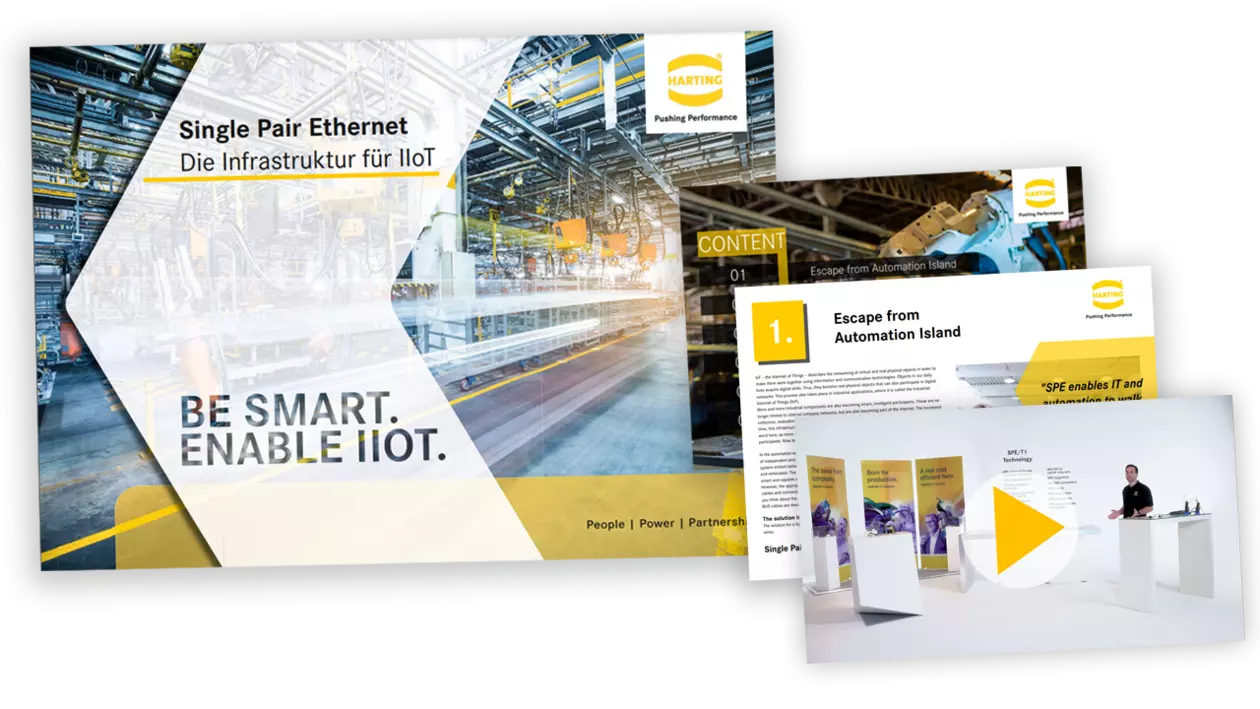Single Pair Ethernet
From sensor to cloud without barriers: SPE is the enabler for the IIoT. With just one pair of wires, SPE makes the field level smart - saving space and costs.

Single Pair Ethernet (SPE) transmits data via Ethernet at speeds of up to 1 Gbit/s with just one wire pair, making it the perfect solution for IIoT and barrier free communication between sensor and cloud. Discover HARTING solutions for Single Pair Ethernet connectivity and cabling and learn about SPE use cases, standards, the ecosystem and why Single Pair Ethernet is the ideal enabler for the IIoT.

Jump to

Single Pair Ethernet explained easily
Your quick start guide: Get to know Single Pair Ethernet in our free eBook and short videos.
What is Single Pair Ethernet?
Single Pair Ethernet (SPE) is a new technology standard that transmits data via ethernet at speeds of 10Mbit/s to 1GBit/s with just one pair of wires, making it the perfect infrastructure solution for IIoT and smart factories. At the same time, Single Pair Ethernet enables the power supply of terminal devices via Power over Data Line (PoDL). Transmission distances of up to 1000 meters make Single Pair Ethernet particularly interesting for use in process automation.
The field level gets smart
Single Pair Ethernet makes the field level smart. It permits the barrier-free connection of equipment, sensors/actuator technology and much more via end-to-end IP-based communications up into the field level. By being able to integrate Ethernet interfaces onto simple sensors, cameras, reading/ID devices or similar equipment, it becomes possible to implement Integrated Industry and IIoT.
SPE delivers a decisive advantage compared with bus systems or analogue current/voltage interfaces, as can still be found in the field level today. Using SPE simplifies the parameter setting, initialisation and programming. The set-up, operation and maintenance of equipment becomes more efficient and more cost-effective. SPE in machines, robots and in rail technology also help to save weight and space. The complete wiring is simpler and also considerably faster to install.

The advantages of Single Pair Ethernet
Transferring data at Gigabit speed via Ethernet with just one pair of wires and simultaneously supplying the devices with power has great potential and offers many advantages.
The demand for Single Pair Ethernet
The trend of digitalization is raising new expectations for communication and cabling technology such as high availability, short access times, fast data transport and the secure transmission of large amounts of data in a wide variety of application environments. At the same time, devices, cables and connection technology should become more powerful, smaller and more robust, as well as offering a high degree of modularity and compatibility. With Single Pair Ethernet (SPE), a new technology is entering the market that meets the new requirements.
Automotive as a pioneer

Single Pair Ethernet is already being implemented in new generations of automobiles, replacing CAN and other bus systems. Controls, communication and safety functions will in future run uniformly via Ethernet. This is a fundamental prerequisite for networked or later autonomous driving.
SPE in industrial automation

The use of Single Pair Ethernet is also worthwhile in industrial automation. Single-pair cabling is fast, space-saving, cost-effective and easy to implement. Equipping simple sensors, cameras and the like with Ethernet interfaces makes SPE a driver of topics such as Integrated Industry and IIoT. This reduces the field level smart and the effort for parameterization, initialization and programming.
How HARTING innovates for SPE
HARTING relies on an alliance of industry, standardisation and research for growing Single Pair Ethernet. As part of this alliance, international standardisation committees have completed a multi-stage selection process in favour of the HARTING Technology Group’s SPE mating face. This also ensures planning security for the designers of new devices or sensor/actuator technology, permitting them to actively commence the implementation of Single Pair Ethernet in the respective device technology.
For HARTING, SPE is a technology topic and the starting point for many new product developments. For the user, however, SPE is not only an opportunity but also a challenge. Is this new technology just as safe as the existing solution? Can SPE also be used in process automation with line lengths of 1000 m? How much power can the end device use? When will SPE connectors and cables be available and will they be adequately standardised? HARTING takes these questions very seriously and has decided to answer them as part of a technology partnership.
The program WIPANO ("Knowledge and Technology Transfer through Patents and Standards") is an initiative of the Federal Ministry of Economic Affairs and Energy which helps to achieve this. HARTING, the University of Reutlingen and LEONI are working together in the NG200 joint project on urgent SPE issues and are simultaneously integrating their results into the international standardisation process. Recently, with the IEC 61076-6, an important step has been made towards specifying weight- and space-saving cabling for an industry-compatible single-pair mating face.


Single Pair Ethernet - FAQ
T1 Industrial - Single Pair Ethernet

Transmission of Ethernet via just one single pair of copper wires. SPE is the perfect technology to connect field devices to the Ethernet network. Single Pair Ethernet technology is fast, space-saving, cost-efficient and ready to implement. The equipping of simple sensors, cameras and more with Ethernet interfaces positions SPE as the driver of topics like Integrated Industry and IIoT.
Available as: CABLE CONNECTOR | CABLE ASSEMBLY | DEVICE SIDE
Single Pair Ethernet standards
Barrier-free data transfer between Cloud and field level - Single Pair Ethernet is changing industrial communication. To make SPE technology widely available, the compatibility of devices, cables and connectors is a top priority. This is ensured by international standardization.
IEC 63171-6
With the publication of IEC 63171-6 in January 2020 by the IEC standards committee SC 48B for connection technology, the Single Pair Ethernet standard has been set. The mating face standard IEC 63171-6 T1 Industrial Style was the first standard submitted by HARTING to SC 48B for a Single Pair Ethernet mating face as early as 2016. The publication of this standard gives users a reliable investment basis for future-proof IIoT networks based on Single Pair Ethernet.IEC 63171-6 (Industrial Style) is a complete standard document with all necessary specifications and test sequences, which is incorporated into current SPE cabling standards of the ISO/IEC 11801-x series of standards for structured cabling.
The implementation of SPE in the ISO/IEC 11801 documents is very important because only in this standard, the cabling channels are described with all necessary parameters (length, number of connections, bandwidth and the complete set of transmission parameters including NEXT, FEXT, shielding properties etc.) with relation to the environment - MICE and can therefore be metrologically verified after installation.
This connection of component standards to connectors and cables provides all users of SPE with clear guidelines for the construction and testing of appropriate transmission links.
The use of cabling components other than those described in ISO/IEC 11801-3 Amd.1, for example, is possible in principle, but then they no longer conform to the standard and carry the risk of incompatibility and loss of function. For this reason, ISO/IEC JTC 1/SC 25/WG 3 and TIA TR-42 launched international selection processes at the beginning of 2018 to define uniform interfaces. These two selection processes were co-initiated by IEEE 802.3, which requested a recommendation for a SPE Media Depended Interface (MDI) from ISO/IEC and TIA.
More than 20 national expert committees participated in this selection process. As a result of this selection process, the mating face according to IEC 63171-6 based on the proposal from HARTING T1 Industrial has become generally accepted for industrial and industry-related applications (M2I2C2E2 and M3I3C3E3).
Single Pair Ethernet ecosystem
Global technology leaders stand behind IEC 63171-6 and IEC 63171-7
Standardised and uniform interfaces are the key to enabling manufacturers to jointly develop the SPE-EcoSystem from sensors, actuators, control units and connection technology and users to create suitable automation solutions from these components.
Founded in 2019, the SPE Industrial Partner Network, a global association of renowned technology leaders, has set itself the task of advancing SPE as a technology for the rapidly growing IIoT market. It offers the emerging
The Partner Network provides clear recommendations for the development of future IIoT applications, is the central information platform and offers security to users that the technology is to be relied upon.










